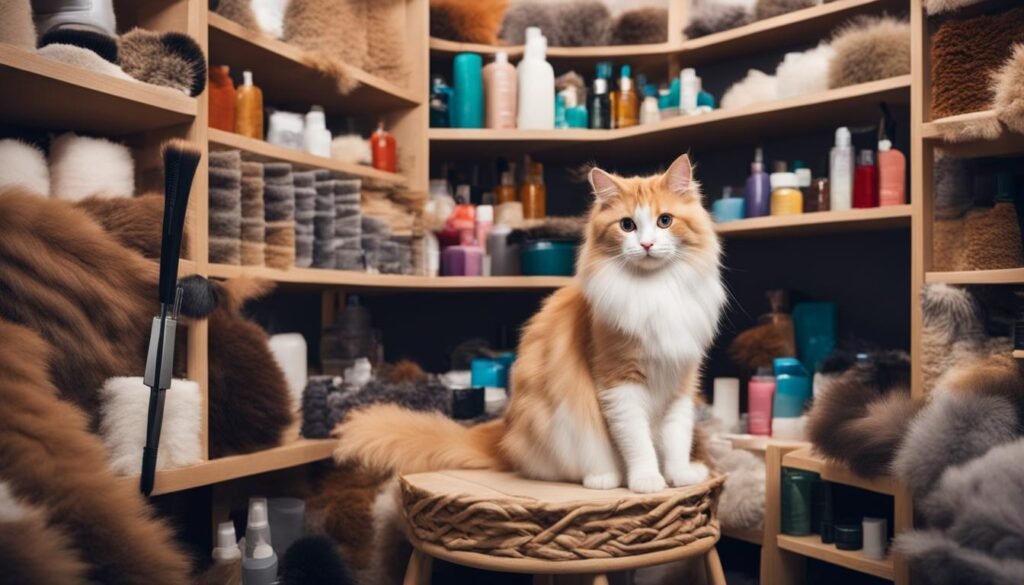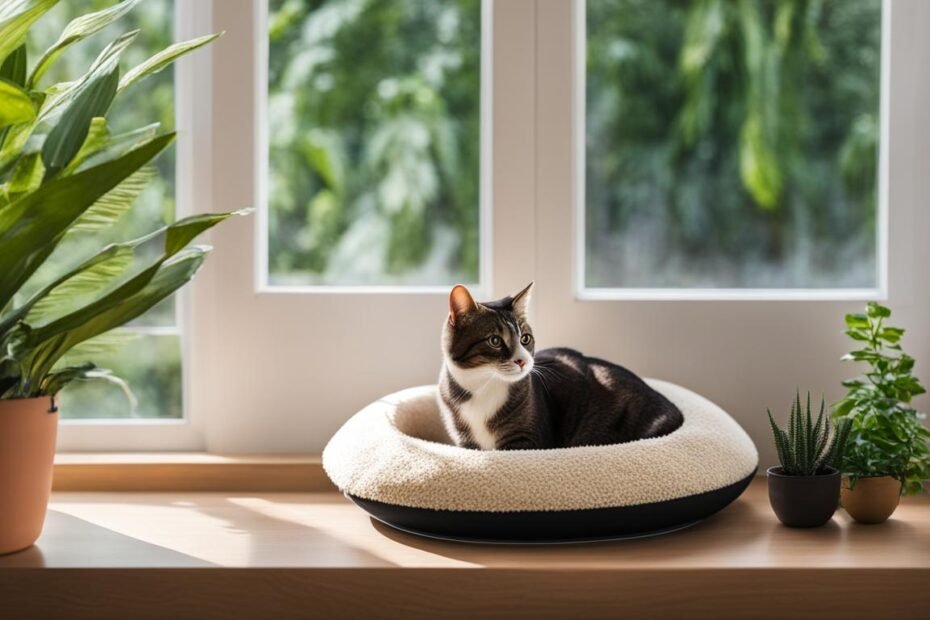Welcome to our guide on creating allergen-free cat zones in your home. If you or your loved ones suffer from allergies, it’s essential to create a safe and healthy environment for both humans and feline companions. In this article, we’ll provide you with tips and tricks to minimize allergens in your home and ensure a comfortable living space for everyone.
Key Takeaways:
- Regular cleaning and vacuuming, along with designated pet-free zones, can help reduce allergens in your home.
- Air purifiers with HEPA filters can effectively remove allergens from the air.
- Regular grooming and bathing of your cat can minimize shedding and allergen spread.
- Keeping the litter box clean is crucial for maintaining an allergen-free environment.
- Choosing unscented cat litter can help reduce dust and odors associated with the litter box.
Understanding Pet Allergens and Allergic Reactions
Allergens originating from pets, such as cats, can trigger allergic reactions in sensitive individuals. These reactions often manifest as sneezing, coughing, wheezing, and itchy eyes. Understanding the source of these allergens is crucial in creating allergen-free zones for cats at home.
Pet allergens are substances that come from an animal’s skin, saliva, or urine. When a person with allergies comes into contact with these allergens, their immune system reacts, causing the symptoms mentioned above. One of the most common sources of pet allergens is cat dander, which consists of tiny flecks of dead skin that shed from a cat’s body.
Cat saliva is another potent allergen. When cats groom themselves, they spread saliva on their fur, which then dries and becomes airborne. Cat urine can also trigger allergic reactions in certain individuals, as it contains proteins that can be highly allergenic.
Allergic Reactions
Allergic reactions occur when the immune system mistakenly identifies these pet allergens as harmful invaders and responds by releasing chemicals, such as histamines, to protect the body. These chemicals cause inflammation and irritation in the respiratory system, leading to the allergy symptoms experienced by sensitive individuals.
Understanding the source of pet allergens is the first step in creating an allergen-free environment for your cat at home. By knowing which substances can trigger allergic reactions, you can take the necessary steps to minimize their presence and ensure a healthier living space for both you and your feline companion.
Now that we have a better understanding of pet allergens and their role in allergic reactions, let’s explore the various strategies and techniques that can be employed to minimize their presence in your home and create a safe and allergy-free zone for your beloved cat.
Minimizing Allergens in Your Home
In order to create an allergen-free environment for both humans and cats, it is important to take proactive steps to minimize allergens in your home. Regular cleaning and vacuuming, establishing pet-free zones, and using air purifiers can significantly reduce the presence of allergens, ensuring a healthier living space for everyone.
One of the most effective ways to minimize allergens is to clean and vacuum your home regularly. Dust, pet dander, and other allergens can accumulate on surfaces and in carpets, triggering allergic reactions. By using a vacuum with a HEPA filter and regularly dusting surfaces, you can remove these allergens from your home, creating a cleaner and healthier environment.
Establishing pet-free zones in your home is another important step in minimizing allergens. Designate certain areas, such as bedrooms or living rooms, as off-limits for your cat. This can help reduce the amount of cat dander and allergens in these spaces, allowing sensitive individuals to have allergen-free areas where they can relax and breathe easier.
Using air purifiers with HEPA filters can also be highly effective in reducing allergens in your home. These devices can remove pet dander, dust, pollen, and other allergens from the air, improving the overall air quality and reducing the risk of allergic reactions. Place air purifiers in rooms where you and your cat spend the most time to ensure that you are breathing clean and allergen-free air.
| Clean and Vacuum Regularly | Establish Pet-Free Zones | Use Air Purifiers |
|---|---|---|
| Regular cleaning and vacuuming can remove allergens from surfaces and carpets. | Designate specific areas as off-limits for your cat to reduce the presence of allergens. | Air purifiers with HEPA filters can remove allergens from the air, improving air quality. |
| Use a vacuum with a HEPA filter to effectively remove pet dander and other allergens. | Focus on keeping bedrooms and living rooms allergen-free for sensitive individuals. | Place air purifiers in rooms where you and your cat spend the most time. |
| Regular dusting and wiping surfaces can help reduce the accumulation of allergens. | Ensure that designated pet-free zones are enforced and respected by all household members. | Consider the size of the room and the air purifier’s coverage area for optimal results. |
By incorporating these practices into your daily routine, you can significantly minimize allergens in your home. Creating a clean and allergen-free environment not only benefits sensitive individuals but also promotes the overall health and well-being of both humans and cats.
Grooming and Bathing Your Cat
Regular grooming and bathing of your cat can help keep them clean and reduce the amount of shedding, ultimately minimizing allergens in your home. By incorporating these grooming practices into your routine, you can create a healthier living environment for both you and your cat.
Tips for Grooming Your Pet:
- Brush your cat’s fur daily to remove loose hair and prevent it from spreading around your home.
- Use a grooming tool specifically designed for cats, such as a slicker brush or shedding comb, to effectively capture and remove loose hair.
- Take extra care when grooming sensitive areas, such as the belly or tail, to ensure your cat remains comfortable throughout the process.
Importance of Bathing Your Pet:
Bathing your cat can also help minimize allergens by washing away loose hair and dander. However, it’s important to note that not all cats enjoy being bathed, so it’s essential to introduce them to the bathing process gradually and make it a positive experience. Here are some tips for bathing your cat:
- Choose a cat-friendly shampoo that is gentle on their skin and free from harsh chemicals.
- Start by filling a shallow tub or sink with warm water and place a rubber mat at the bottom for your cat’s comfort and stability.
- Gently wet your cat’s fur and apply the shampoo, being careful to avoid their face and ears.
- Rinse thoroughly with warm water, ensuring all the shampoo is washed away.
- Use a towel to gently dry your cat and provide them with a warm and cozy spot to finish drying naturally.

Grooming and bathing your cat regularly not only helps minimize shedding and allergens but also promotes a strong bond between you and your furry friend. By incorporating these practices into your cat’s care routine, you can create a clean and allergen-free environment for everyone to enjoy.
Keeping the Litter Box Clean
One of the key factors in creating an allergen-free cat zone is maintaining a clean litter box. Regular cleaning and proper waste disposal not only help reduce litter box smells but also minimize the presence of allergens in the environment. By following a few simple steps, you can ensure a fresh and odor-free atmosphere for both you and your feline companion.
How to Keep the Litter Box Clean:
- Scoop out waste daily: It’s important to scoop out the waste from the litter box at least once a day. Removing solid waste promptly helps prevent odor buildup and maintains a clean litter box environment.
- Replace litter regularly: In addition to scooping out waste, it’s essential to replace the litter on a regular basis. This helps maintain freshness and prevents the accumulation of bacteria and unpleasant odors. Follow the manufacturer’s instructions on how often to change the litter.
- Clean the litter box: For a thorough clean, empty the litter box completely and wash it with mild soap and water. Make sure to dry it thoroughly before adding fresh litter. Regular cleaning helps eliminate any lingering odors and keeps the litter box hygienic.
Tip: Consider using a litter box with a built-in odor control system or an enclosed litter box to further reduce litter box smells and contain the litter within the box.
Maintaining a clean litter box is an essential part of creating an allergen-free cat zone. By scooping out waste daily, replacing litter regularly, and cleaning the litter box, you can reduce litter box smells and ensure a fresh and odor-free environment for both you and your cat.
Table: Comparison of Different Types of Litter Box Cleaners
| Litter Box Cleaner | Key Features |
|---|---|
| Clumping Litter | – Forms solid clumps for easy scooping – Helps control odor – Absorbs moisture |
| Non-Clumping Litter | – Absorbs moisture – Controls odor – Doesn’t form clumps for easy scooping |
| Natural/Alternative Litters | – Made from renewable materials – Biodegradable – Limited dust and tracking |
| Scented Litter | – Helps mask litter box odors – Provides a fresh scent – May cause sensitivities in some cats or humans |
Table: Comparison of Different Types of Litter Box Cleaners
Choosing the Right Cat Litter
When it comes to creating an allergen-free environment for your cat, choosing the right cat litter is essential. Opting for unscented cat litter, such as Tidy Cats Free & Clean, can make a significant difference in reducing dust and odors associated with scented litter.
Tidy Cats Free & Clean is specially formulated to provide a cleaner and fresher litter box environment. With its 99.9% dust-free composition, it helps minimize the amount of dust particles that can trigger allergies and respiratory issues in both humans and cats. This makes it an ideal choice for those with sensitive noses or asthma.
In addition to reducing dust, Tidy Cats Free & Clean offers TidyLock Protection. This unique feature locks away odors, ensuring your home remains fresh and odor-free. By eliminating unpleasant smells, it creates a more pleasant living space for you and your furry friend.
| Benefits of Tidy Cats Free & Clean: |
|---|
| 99.9% dust-free composition |
| TidyLock Protection to lock away odors |
By choosing Tidy Cats Free & Clean, you can provide your cat with a clean and comfortable litter box experience while reducing allergens in your home. Say goodbye to dusty paws and unpleasant odors, and create a healthier environment for both you and your feline companion.

Creating a Cat-Friendly Home Design
When it comes to creating an allergen-free environment for your cat, the design of your home plays a significant role. By implementing a cat-friendly home design, you can minimize allergen accumulation and promote a healthier living space. One of the key considerations in cat-friendly home design is choosing the right flooring.
Choosing Hard Flooring
Hard flooring, such as hardwood or tile, is highly recommended for cat-friendly homes. Unlike carpets, hard flooring does not trap allergens like cat dander, pollen, or dust. It is easier to clean and maintain, making it an ideal choice for minimizing allergen accumulation. Additionally, hard flooring can withstand scratches from your cat’s claws, ensuring longevity and durability.
When selecting hard flooring, opt for smooth finishes rather than textured surfaces. Textured surfaces can trap dust and allergens, making cleaning more challenging. It’s also advisable to choose flooring with a low VOC (volatile organic compounds) emission, as some flooring materials can release harmful chemicals into the air, aggravating allergies.
Creating Pet-Free Zones
Incorporating designated pet-free zones in your home can help minimize allergen exposure for sensitive individuals. These zones can be areas where your cat is not allowed, such as bedrooms or certain living spaces. It’s essential to communicate and reinforce boundaries with your cat through training and providing alternative spaces or furniture for them to enjoy.
Quote: “By creating pet-free zones, you can provide allergy sufferers in your household with a safe haven where they can find relief from potential allergens.” – Dr. Emily White, Veterinary Allergist
Furniture and Allergen Control
Choosing furniture that is easy to clean and maintain is another key aspect of cat-friendly home design. Opt for leather or vinyl furniture, as these materials are less likely to trap allergens compared to fabric upholstery. Additionally, using removable and washable covers for cushions and pillows can help control allergen accumulation and promote a clean living space.
Regular cleaning and dusting of furniture is essential to remove any potential allergens. Use a vacuum cleaner with a HEPA filter to effectively capture and contain allergens. This will significantly reduce the presence of airborne allergens, promoting a healthier environment for both humans and cats.
By implementing a cat-friendly home design, you can create a space that minimizes allergen accumulation and enhances the well-being of both you and your cat. From choosing the right flooring to creating pet-free zones and selecting furniture with allergen control in mind, these strategies will help you create an allergen-free environment that promotes a happy and healthy coexistence.
Conclusion
Building immunity to cat allergies and reducing allergens in the home is essential for living comfortably with our feline companions. By following the tips and recommendations mentioned in this article, you can create perfect allergen-free cat zones in your home.
Regular cleaning and vacuuming, establishing pet-free zones, and using air purifiers with HEPA filters can significantly reduce the presence of allergens in your living space. Grooming and bathing your cat regularly can help minimize shedding and the spread of allergens. And don’t forget to keep the litter box clean, as a fresh and odor-free environment is crucial for an allergen-free home.
Choosing unscented cat litter, such as Tidy Cats Free & Clean, can further reduce dust and odors, ensuring a clean and fresh litter box. Additionally, creating a cat-friendly home design with hard flooring and furniture made of materials like leather or vinyl can help minimize allergen accumulation.
By implementing these strategies, you can reduce allergens in your home and create a safe haven for both you and your cat. With a healthier living environment, you can enjoy the company of your feline friend while minimizing allergic reactions. Remember, living comfortably with cats is possible with the right approach!
FAQ
What are common pet allergens that can trigger allergic reactions?
Pet allergens such as cat dander, saliva, and urine can trigger allergic reactions in sensitive individuals.
How can I minimize allergens in my home?
Regular cleaning and vacuuming, establishing pet-free zones, and using air purifiers with HEPA filters can help reduce the presence of allergens in your home.
How can I reduce shedding and minimize allergens from my cat?
Regular grooming and bathing of your cat can help reduce shedding and minimize the spread of allergens. Brushing your cat’s fur daily and giving them regular baths can remove loose hair and dander, reducing allergens in your home.
How often should I clean the litter box?
It is important to scoop out the waste from the litter box daily and clean the litter box regularly to help reduce litter box smells and maintain an allergen-free environment.
What type of cat litter should I use?
Opt for unscented cat litter, such as Tidy Cats Free & Clean, to minimize dust and odors associated with scented litter. This cat litter is 99.9% dust-free and offers TidyLock Protection to lock away odors, providing a clean and fresh litter box environment.
How can I create a cat-friendly home design?
Choose hard flooring like hardwood or tile instead of carpets to prevent allergens from getting trapped. Using leather or vinyl furniture and covers can also make it easier to remove allergens and maintain a clean living space.
